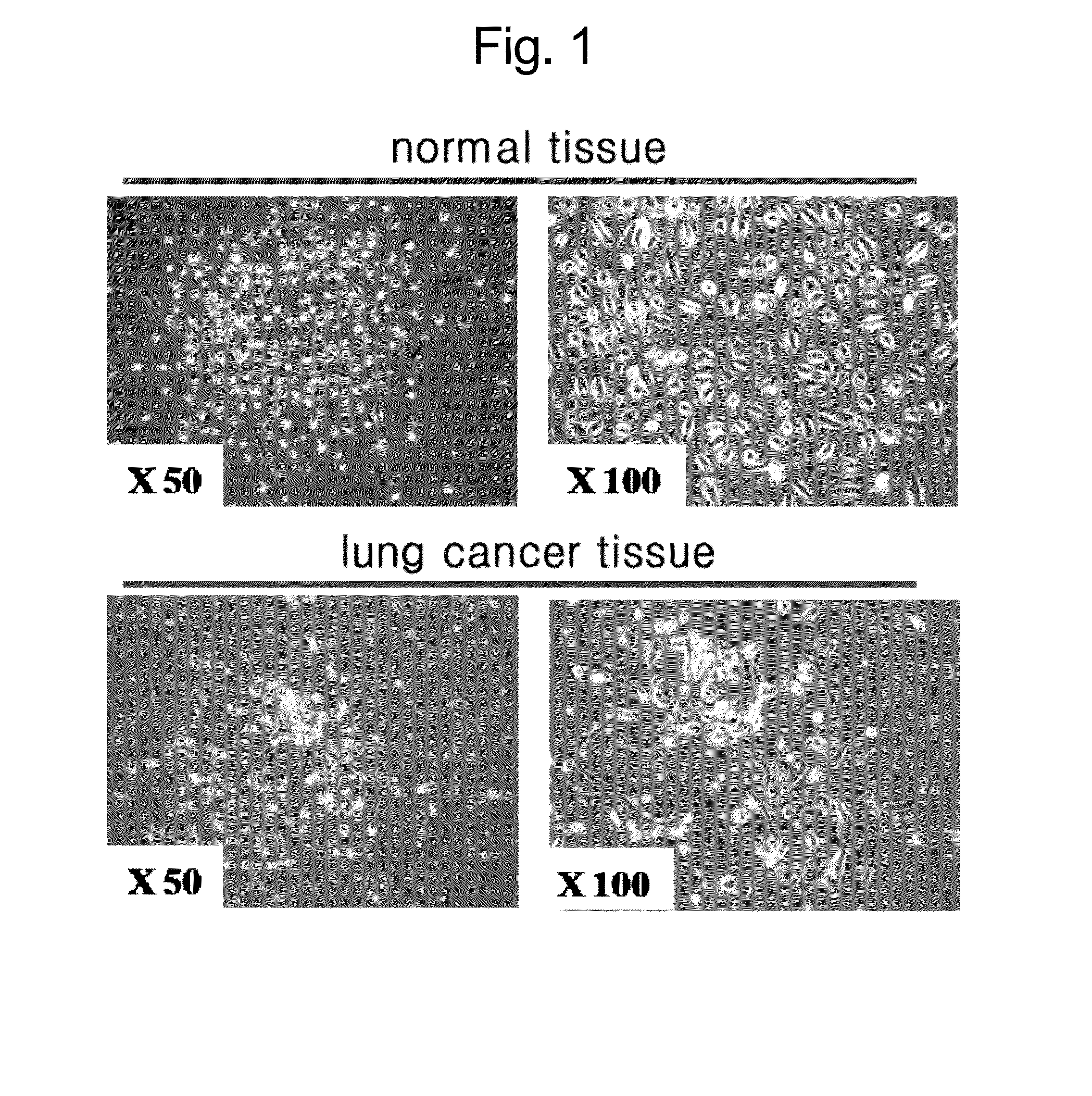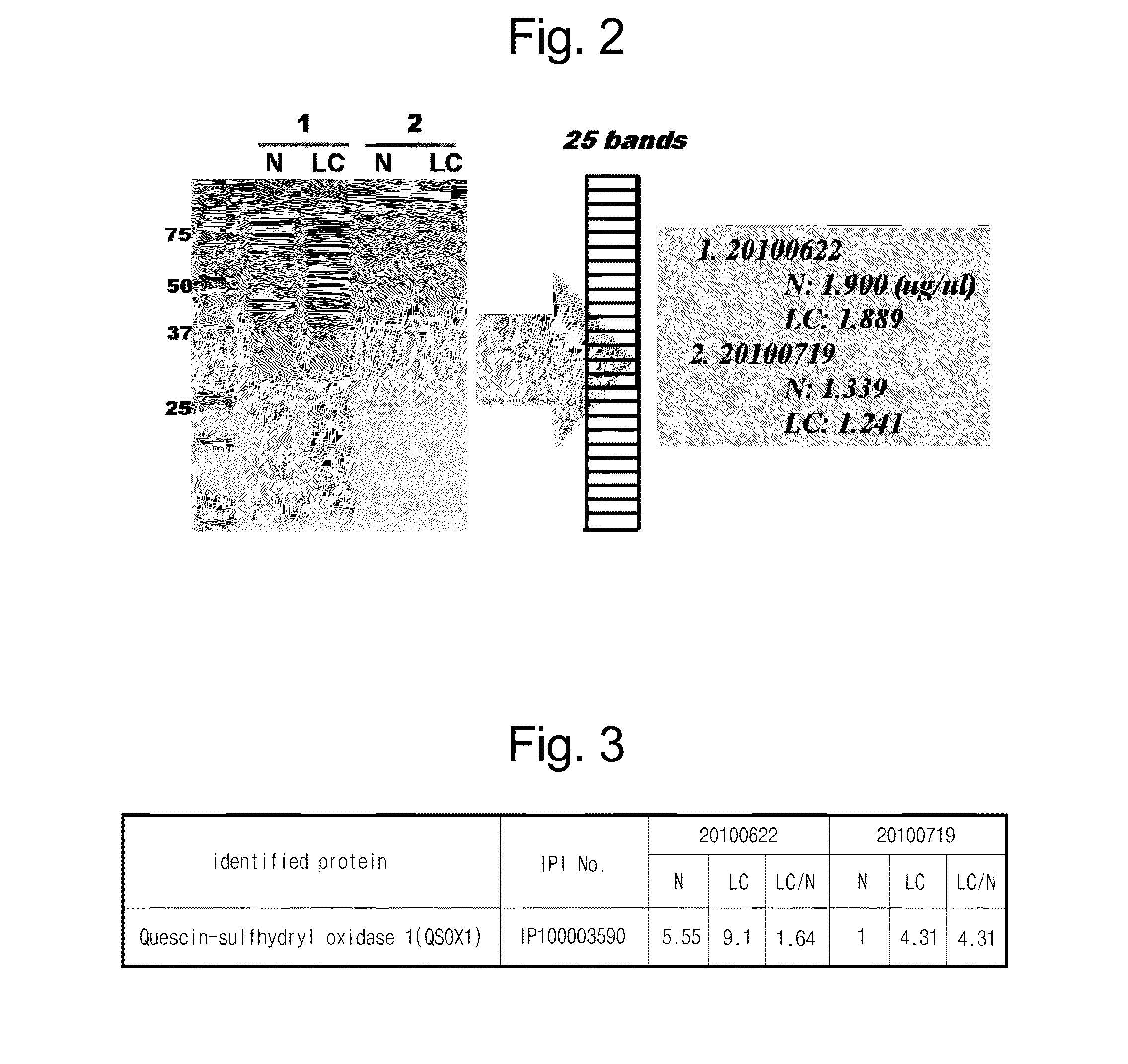Composition for diagnosis of lung cancer and diagnosis kit of lung cancer
a lung cancer and composition technology, applied in the field of composition for diagnosis of lung cancer and a lung cancer diagnosis kit, can solve the problems of lack of a high-sensitivity early diagnosis method, lack of commercialized biomarkers capable of specifically diagnosing lung cancer, and insufficient specificity and sensitivity. achieve excellent sensitivity and specificity
- Summary
- Abstract
- Description
- Claims
- Application Information
AI Technical Summary
Benefits of technology
Problems solved by technology
Method used
Image
Examples
example 1
Test Sample Collection
[0053]A system for primary culture using a lung cancer tissue and a surrounding normal tissue obtained from a lung cancer patient was secured. The lung cancer tissue and the surrounding normal tissue were maintained in a fresh state, and were chopped by using scissors or a blade in accordance with a mechanical method. Then, they were treated with collagenase type I, reacted for 30 minutes to 90 minutes at 37° C. so as to separate single cells. Then, they were plated onto a medium containing 10% FBS, and cultured.
[0054]In a case of a cell separated from the normal tissue, a typical epithelial cell type of pebble-shaped circular cells were grown, while in a case of a cell separated from the lung cancer tissue, fibrocyte-like shaped cells were grown in a long form (see FIG. 1).
example 2
Separation and Concentration of a Secreted Protein
[0055]Cells from Example 1 were subcultured twice to three times so as to collect a protein secreted during a culturing process. In subculture 3, the same number of cells were counted, and they were transferred to a new culturing plate, and cultured for 48 hours to collect a medium including a secreted protein.
[0056]Then, in order to remove the FBS content contained in a subculture medium of the normal cell plate and the lung cancer cell plate, each plate was sufficiently washed. Then, the medium was replaced by a serum free media, and culturing was performed for 24 to 48 hours. In this process, in order to obtain a protein secreted from each cell, a TCA precipitation method was used for protein concentration.
example 3
Separation and Coomassie Blue Staining of SDS-PAGE
[0057]The protein from Example 2, which was secreted from the normal tissue cell and the lung cancer tissue cell and concentrated, was separated through SDS-PAGE, and the gel was washed with ddH2O three times (each for 5 minutes). Then, the protein was added with Coomassie G250 Stain (BioRad, Hercules, Calif.), and softly shaken at room temperature for 1 hour for staining. In the coomassie staining, in each pair (N: a protein secreted from a normal tissue, LC: a protein secreted from a lung cancer tissue), the proteins were used for the experiment in the same amount (see FIG. 2).
PUM
| Property | Measurement | Unit |
|---|---|---|
| electrophoresis | aaaaa | aaaaa |
| fluorescence activated cell sorter | aaaaa | aaaaa |
| CT | aaaaa | aaaaa |
Abstract
Description
Claims
Application Information
 Login to View More
Login to View More - R&D
- Intellectual Property
- Life Sciences
- Materials
- Tech Scout
- Unparalleled Data Quality
- Higher Quality Content
- 60% Fewer Hallucinations
Browse by: Latest US Patents, China's latest patents, Technical Efficacy Thesaurus, Application Domain, Technology Topic, Popular Technical Reports.
© 2025 PatSnap. All rights reserved.Legal|Privacy policy|Modern Slavery Act Transparency Statement|Sitemap|About US| Contact US: help@patsnap.com



